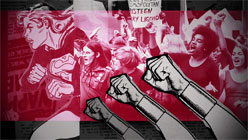Exactly 40 years ago, Ms. debuted on national newsstands, and the first issue left little doubt the magazine had a feminist perspective. The cover had Gloria Steinem’s name on prominent display (“Gloria Steinem on How Women Vote”); a tease to an article explaining why unshaved legs were a political statement (“Body Hair: The Last Frontier”); and an image of the comic-book hero Wonder Woman, who was shown combating war and injustice below the headline, “Wonder Woman for President.”
It was a heady time for feminism. And it was a heady time for Wonder Woman, who was seen by many feminists (Steinem included) as the embodiment of strength, fearlessness, and determination. The new documentary, Wonder Women! The Untold Story Of Superheroines, deconstructs pop culture’s greatest female characters — the ones with extra-special powers who made it to the realm of comic books, TV, or Hollywood — and explains why they’ve had mixed success: On the one hand, Wonder Woman and her cohorts became an inspiration for generations of girls and women; on the other hand, popular female super figures are few in number compared to male figures, and they’ve been subjected to plot twists that seem completely misogynistic. In the late ’60s, DC Comics had Wonder Woman lose her original super powers, and in previous years, the publisher had Wonder Woman more focused on falling in love than saving humanity.
Sussing out these contradictions is one of the strengths of Wonder Women!, which screens Saturday in San Francisco at the Celebration of Craftswomen at Fort Mason and next Wednesday at 235 Montgomery Street in an event hosted by the International Museum of Women. PBS’ Independent Lens is scheduled to broadcast the documentary in April.
“For female characters, it’s mostly through the sexualization of them that they become more compromised,” says Kristy Guevara-Flanagan, the director of Wonder Women!, who grew up in the mid-to-late ’70s watching the Wonder Woman TV series. “There are moments when you have to cringe. You parse out the different parts of their stories and representations, and there’s almost this unconscious way that women read mass media because our characters often die quickly or their strength is mitigated or they’re just not essential heroes.”





